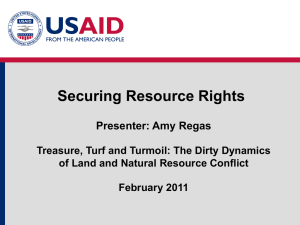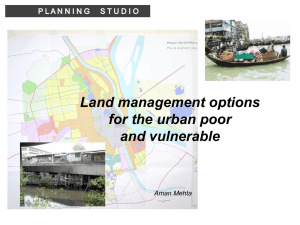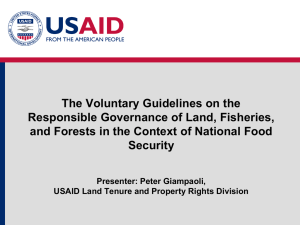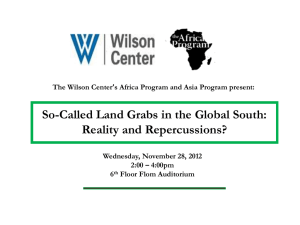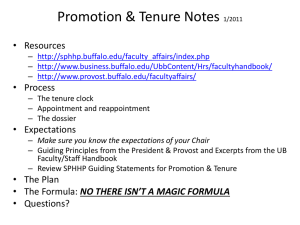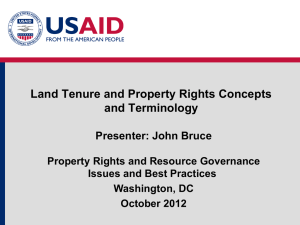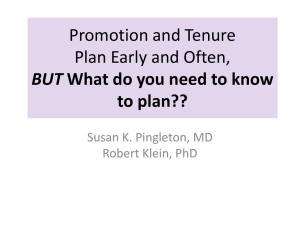Honheim Lecture VGGT Case study
advertisement
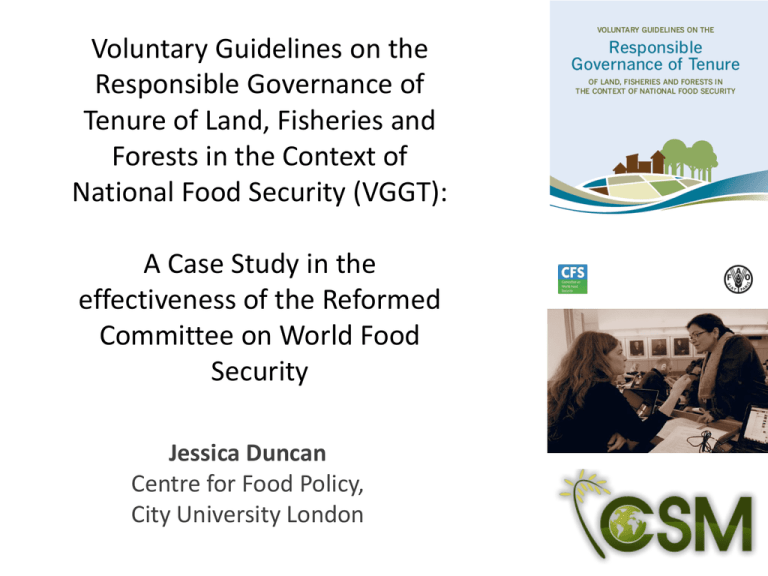
Voluntary Guidelines on the Responsible Governance of Tenure of Land, Fisheries and Forests in the Context of National Food Security (VGGT): A Case Study in the effectiveness of the Reformed Committee on World Food Security Jessica Duncan Centre for Food Policy, City University London Structure of the Presentation Part 1 Setting the Scene: - Reform of the Committee on World Food Security - Development of the Civil Society Mechanism Aim: provide context for, and awareness of, reform of the CFS Part 2 Methods: - Doing participant observation - Solidarity research Aim: to review participant observation as solidary research method ; Part 3 Case Study: VGGTs Aim: illustrate the role of CSOs in negotiations; provide a review of the Guidelines; reflect on the future of the CFS PART 1- Setting the Scene Bridging the gap: Global governance – local governance Catalyst for Change • Between 2007 and 2008, the world’s staple food prices soared to their highest levels in 30 years: more than 1 billion people were chronically hungry • Prices peaked in June 2008 (but then fell 33% in 6 months) • Food riots broke out in more than 60 countries • Rising food costs in 2010-11 pushed nearly 70 million people into extreme poverty • Marked by 7 main policy reactions: Policy coherence and cohesion; Relief; Increased Productivity; Improved Markets; Increased Investment; Country-led Plans; Sustainability • Battle for leadership: coherence = highly political Committee on World Food Security • 1974: Established upon recommendation of the World Food Conference (Response to 1970s food crisis) • 2009: Reform process initiated to address calls for greater coordination and cohesion of food security policies • 2010: First Session of the Renewed CFS (36th) • Now: Emerging consensus that the CFS is the forum for discussion and debate on global food security governance (rhetoric vs practice) Vision of the CFS “To constitute the foremost inclusive international and intergovernmental platform for a broad range of committed stakeholders to work together in a coordinated manner and in support of country-led processes towards the elimination of hunger and ensuring food security and nutrition for all human beings” Key Issues Addressed by the CFS CFS 36 (2010) Issue Addressing food insecurity in protracted crises: Issues and Challenges Land tenure and international investment in agriculture Managing vulnerability and risk to promote better food security and nutrition 37 (2011) How to increase food security and smallholder-sensitive investment in agriculture Gender, Food Security and Nutrition Food Price Volatility Methods for calculating number of food insecure 38th (2012) Voluntary Guidelines on the Responsible Governance of Tenure of Land, Extraordinary Fisheries and Forests in the Context of National Food Security 39 (2012) 40th (2013) Climate Change Social Protection Global Strategic Framework Principles for Responsible Agricultural Investment Investing in smallholder agriculture for food security and nutrition Biofuels and food security Civil Society Mechanism • CSM facilitates the participation of CSOs in the CFS, including input in negotiations and decision-making • Provides a space for dialogue between a wide-range of civil society actors • Facilitates local struggles into political processes • Open to all CSOs working on food security • Executive: Coordination Committee (CC) comprised of 41 focal points from 11 constituencies and 17 subregions • www.csm4cfs.org Sub-Regions (Total of 17, x1 focal point each) North America South East Asia Central America & Caribbean Central Asia Andean Region Oceania Southern Cone Southern Africa Western Europe West Africa Eastern Europe East Africa West Asia Central Africa South Asia North Africa Pacific Constituencies (Total of 24, x2 focal points each) Agricultural & food workers NGOs Artisanal fisherfolk Smallholder family farmers (4 focal points) Consumers Pastoralists Indigenous Peoples Landless Urban poor Women Youth CSM Working Groups Role of CSM Working Groups • To enhance circulation of relevant documentation and information on the issue and on the related process in the CFS • To provide a space for dialogue and the exchange of views • To provide a space for CSOs to develop strong civil society positions Working Groups • • • • • • • • • • • • Land Tenure Agricultural Investment Global Strategic Framework Gender Nutrition Price Volatility Protected Crisis and Conflict Monitoring and Mapping Social Protection Climate Change Biofuels CFS Programme of Work PART 2- Participant Observation Aims of this Section 1. Make a case for participant observation (in solidarity with food social movements) 2. Discuss how and why I conducted fieldwork (as solidarity research) in a UN committee 3. Identify some of the challenges I faced/lessons learned 4. Frame the case study “The Field” • The “field” is not an objective place • Site of reciprocal and contested relationships (Domosh 2003) • Site where actors co-construct meaning through various forms of interaction • These meanings are not static: they are continuously constructed, reconstructed, deconstructed, and enacted through interactions (or lack of thereof) • It is important not to assume that shared experience results in shared meaning CFS = Interface space which constitutes “important terrains for confrontations between social movements and the defenders of the neoliberal agenda that has dominated the world’s community’s discourse and actions over the past 3 decades” (McKeon 2009:48) Benefits of Participant Observation/Solidarity Research • For Participant Observation: • Interviews = limited, actions don’t always align with words • Vantage point – as a co-constructor of meaning • For Solidarity Research: • Social movements produce knowledge • Connected by virtue of your position • Social movements = conducive sites to privilege meaning-making: activities foreground resistance to dominant norms and institutions (Kruzman 2008) • Reinforced through interviews with CFS negotiators • Raise possibilities of alternative world-views which challenges those engaged to rethink meanings often taken for granted Doing Participant Observation • • • • • What I needed • Language Gate keepers – Cultural and linguistic – Fundamental role of Flexibility (a must) interpreters: voice -trust – Value of English (*) Consultation • Blog Feedback – Transparency – Public profile Hard work – Exposure – – – – Remaining a-political (*) Networking tool Motivation Archive of thinking and process Key Challenges • Speaking social movement(s) and across cultures • Research/participant binary is critical • Negotiation of power relations, responsibilities and hierarchy within the constraints of the research project – How to assessing truth claims (avoid locking participants into a time and place of meaning (Domosh 2003) – Ontological argument for viewing experiences and broader processes as mutually constitutive • Researcher-CSO dynamics (shifting role) – Insider, outsider, both and neither (Mullings 1999) Key Challenges cont. • Gender politics – Bargaining with Patriarchy (Kandiyoti 1988, 1998) • Time- methodological tension in ethnography • Dealing with political sensitive analysis – Academic expectations vs solidarity vs capacity • Protecting participants • Emotion (highs/lows) – How to address this personally & academically – Getting too involved? PART 3- Voluntary Guidelines on the Responsible Governance of Tenure What are the VGGTs • Guidelines to promote responsible governance of tenure of land, fisheries and forests, with respect to all forms of tenure: public, private, communal, indigenous, customary, and informal • Goals: achieve food security for all & support the progressive realization of the right to adequate food • Best practices for governance of tenure of natural resources • Strengthen the capacities and operations of actors • Tool to assess land tenure policy What they are not • Not targeted at land grab • Not enforceable Why should we care? • Secure tenure rights are fundamental to food security • International standards to ensure responsible governance of natural resources • HR-based instrument- shifts focus of land policies to the implementation of the RTF and in turn disadvantage people Negotiation the Guidelines • Key issues for CSOs – Rights-based approach – Food security goals – Principles of inclusion: list of small-scale producers – Investment in association with land holders, different models of production and land use, informal tenure systems – Monitoring • Tension between success of process and quality of document Guiding Principles General Principles Principles of implementation • States to recognise and respect all legitimate tenure right holders • Safeguard legitimate tenure rights • Provide access to justice to deal with infringement of legitimate tenure rights • Non-state actors including businesses have a responsibility to respect human rights and legitimate tenure rights • • • • • • • • • • Human dignity Non-discrimination Equity and justice Gender equality Holistic and sustainable approach Consultation and participation (taking into consideration existing power imbalances) Rule of law Transparency Accountability Continuous improvement What do the VGGTs cover? - Legal recognition and allocation of tenure rights and duties - Safeguards; Public resources; Indigenous Peoples; Informal tenure - Transfer and other changes to tenure rights and duties - Markets; Investments; Land consolidation; Restitution; Redistributive reform - Administration of tenure - Record of tenure rights; Valuation; Taxation; Resolution of disputes; Transboundary matters - Responses to climate change and emergencies - Climate change; Natural disasters; Conflict - Promotion, implementation, monitoring and evaluation Assessment of the VGGTs Pros • Consultative and inclusive process for developing the Guidelines • CSOs participated at all stages including the negotiations, to draw attention to the real-life issues facing them and to make concrete proposals • VGGTs respect and protect human rights in the context of tenure • Emphasis is on women, peasant farmers, fishing communities, pastoralists and indigenous peoples • Principles of implementation, Evidence of the capacity of the CFS Assessment of the VGGTs Cons • Do not explicitly challenge assumption that large-scale investments in industrial agriculture, fisheries and forests are essential for development • Did not prioritise support to small-scale food producer groups • VGGTs do not consolidated the recognized rights of indigenous peoples, as articulated in UNDRIP and other international instruments, in the context of tenure • Water resources were excluded from the scope of the VGGTs = gap that challenges the relevance of the Guidelines in many regions • Enthousiasm v Political Will to take up the VGGT at the national level • Framed in the context of developing countries Limitations of Food Security • Technocratic definition and approach • Apolitical: fails to accept the political processes that contribute to food insecurity • States are being asked to monitor their own progress and to prioritise development • States predominantly continue to prioritise economic values: food security as an outcome of strong economy Policies Against Hunger 2013 Recommendations from the Conference • Working Group 1: Governing Land Responsibility – Build on existing experiences; safeguards processes; VGGT is technical process and also social and political issue; build up complaint and dispute resolution mechanisms • Working Group 2: Conflicts over Land – VGGT to break cycles of conflict; states to incorporate the VGGT in national law and policy; recognise and strengthen customary tenure – CFS play role to exchange best practice in achieving effective integration of formal and customary systems for resolving tenure disputes- customary systems are not universally positive- need to address their shortcomings from a rights-based perspective being careful not to jeopardize legitimacy – UN HR expert study on integrating customary systems and principles with human rights law- possible HRC Expert Advisory Committee Policies Against Hunger 2013 Recommendations from the Conference • Working Group 3: Investment in Land – national multi-stakeholder platforms; VGGTs as standard when entering into cooperation with other countries; Set up monitoring and complaint mechanism CSOs to disseminate VG message, monitor investments and us VGGT as yardstick and report to governments and CFS – Financial investors to apply VGGTs in their operations • Working Group 4: Monitoring Progress towards Decisions and Recommendations – CFS to assess progress towards implementation, short, medium, long term – Link national and regional processes and platforms – Develop quantitative and qualitative indicators reflecting principles of GSF (para 92 & 93) – Support capacity building for monitoring and evaluation to enhance accountability Now what? • There is an assumption about the goodwill to implement but implementing guidelines on such a contentious issue will be tricky • These guidelines are voluntary, so what do we do? – based on HR approaches. We can encourage countries that have traditionally championed human rights to take the lead • Explore how to use mandatory HR monitoring and see how we can link • Need to have mechanisms to hold all investors to account • Implementation cannot happen without accountability which will not happen without monitoring • Monitoring is the first steps to moving towards real implementation: “to move from paper to justice” Thank You Contact/Questions jessica.duncan.2@city.ac.uk Download Presentation foodgovernance.com Key Issues Remaining • • • • • Communication – Translation – Maintaining politically negotiated language Assessment – How to use VGGT to assess national policies; coherence Cohesion – How to make the link between regional initiatives (AU Land Policy Initiative) and the VGGTs Implementation – Very political issue; how to raise political will? – Regional level? Monitoring – Challenges of attribution – Staged approach? Mixed methods: value of case studies – Indicators: appropriate? Context dependent – Assess end goal: improved tenure rights and food security CSO engagement: Effective Strategies • Technical Capacity/ Knowledge • Political Savvy • Coherent Political Framework • Positivity • Linking back to the CFS’s Mandate & HLPE • Alliances • Legitimacy Technical Capacity • NGOs and social movements have people dedicated to working on key issues = high level of technical knowledge and expertise • Diversity of actors from many perspectives enhances this • They make strong interventions are often provide strong references to academic literature, international law, etc. Political Savvy • CSOs are increasingly competent and confident in the workings of the CFS • Able to assert themselves more effectively • Prepare clear strategies based on key demands, red lines and their own values in a consultative manner • Constant evaluation and reflection to inform strategy • Flexible in their approach • Social Movement v. NGO Coherent Political Framework Positivity • Food Sovereignty as unifying principles of a global social movement • Also a well articulated political framework • Undertakes a rigorous political analysis of agricultural policies and programmes with a focus on relations of power and control of resources • Production – not productionist – centred • CSOs make positive contributions • Generally aim to stay positive with interventions • Propose solutions to critique • Highlight their processes as a model of cohesion and consensus building • Even use humour at times Linking back to the goals of the CFS • Framing proposals within the context of the CFS mandate was successful – Food security – Most vulnerable populations – Right to Food Alliances • Strong alliances amongst civil society have proven useful: speak as one • Alliances with countries and regions, including meetings to share positions, working on shared positions, seeking backing for amendments, has proven very powerful • CSO positions gain strength when backed by governments (and vice versa) Legitimacy • CSO actors have the capacity to speak about on the impact of policies on their communities • They have more freedom to break through the political speak and call governments to account • AU holds a lot of legitimacy in these negotiations as well Challenges: CSO Participation • • • • • Language Scope Coherence Power Politics Limitations of Food Security Language • Texts are negotiated in English, leaving many people out of the negotiations • Speaking social movement versus speaking UN Scope • Tenure of natural resources security is complex and politically sensitive • Brings together many actors – Challenges communicating across sectors – Turf wars – Political v. Technical Process Coherence • Operating under notion that cohesion is lacking • CFS has a mandate to enhance cohesion • Questions about AU Land Policy Initiative • Cohesion is also a highly political process: which policies need to be changed and which are to be upheld? – CSOs argue that the CFS policies are most legitimate because they are most inclusive – Contrast = G8’s New Alliance or PRAI Power Politics • Increased interest by financial actors (land grab, speculation, commodities trading) – Rio +20 – Green Economy • Land is on the G8 Agenda: transparency • Shifting geopolitics (BRICS) • G8/G20 What Now? • Implementation has been encouraged by the G20, Rio+20, the Francophone Assembly of Parliamentarians and the UN General Assembly • FAO has made the VGGTs a priority • As of February 2013, the FAO had supported 10 awareness raising workshops, 17 country-level workshops had been requested and 53 briefings in 33 countries had been completed • Country requests received from Myanmar, Namibia, Philippines, Sierra Leone, Zambia, South Sudan • Capacity development tools: technical guides (e.g., gender, indigenous peoples), and e-learning programme What Now: CSOs • Land Tenure Working Paper: Monitoring the VGGTs: A civil society perspective (FIAN International 2012) • IPC+ Working Group on Land and Territory on the Tenure Guidelines met in early February • WG has developed a proposal for a set of materials and activities on the Tenure Guidelines to be developed by social movements and CSOs for their own members • These activities include: elaborate a Capacity Building Manual; carry out capacity building workshops; develop audiovisual materials; and set up a common website for social movements’ platforms to share information on how the Guidelines are used in their struggles for access to resources
